Most wasps are black and yellow. Red and black wasps aren’t seen as commonly.
Multiple red and black wasps are found in the US. Some are even native to North America.
Red and black wasps can live solitary lives or social lives. Those living alone typically use burrows to rest and lay eggs while social wasps build colonies and nests.
Table of Contents
Are Red and Black Wasps Dangerous?
Red and black wasps can be dangerous and very dangerous, depending on their venom and sting capacity.
Some of the most painful insect stings are known to come from red and black wasps.
Eastern Tawny-horned Spider wasps are known for having one of the most painful stings in the world of wasps. This is a black and red wasp species commonly found in the US.
Types of Red and Black Wasps
The following red and black wasps are most common in North America.
1. Dark Paper Wasp

Dark Paper wasps (Polistes fuscatus) are some of the most commonly red and black wasps.
These insects have an elongated red-brown body with black and yellow bands. Its legs are also red.
Adult Dark Paper wasps are led by a queen in their social colony.
These wasps solely feed on plant nectar but they can be categorized as insectivores as Dark Paper wasp larvae eat insects.
The larvae of these wasps eat caterpillars.
Adults feed on nectar and help plant pollination as they visit multiple flowers each day.
2. Ringed Paper Wasp

These red and black wasps (Polistes annularis) grow to a size of up to 25mm.
Wasps of this genus have slightly different coloring depending on their area. Those living in the Northern areas have red and black coloring while those in the South have brown and black coloring.
Ringed Paper wasps eat various insects and insect larvae.
Caterpillars and moths are among the most common prey for Ringed Paper wasps.
The queen Ringed Paper wasps established a colony and the first brood of workers.
3. Coarse-backed Red Paper Wasp

This wasp species (Polistes rubiginosus) has a mostly red color. It shows faded black lines and stripes across its body.
Coarse-backed Red Paper wasps also have black wings.
These wasps have no yellow coloring like other species. They might exhibit bright colors, but these are typically attributed to certain areas of the body where light brown is prevalent.
Growing to a size of 18mm, the Coarse-backed Red Paper wasp is found across the US.
Also seen in warm climates and Florida habitats, this wasp prefers to build nests in holes, cavities, buildings, and other sheltered locations.
Wasps of this genus can build nests in hollow trees, on walls, or under patios.
4. Hidalgo Mason Wasp
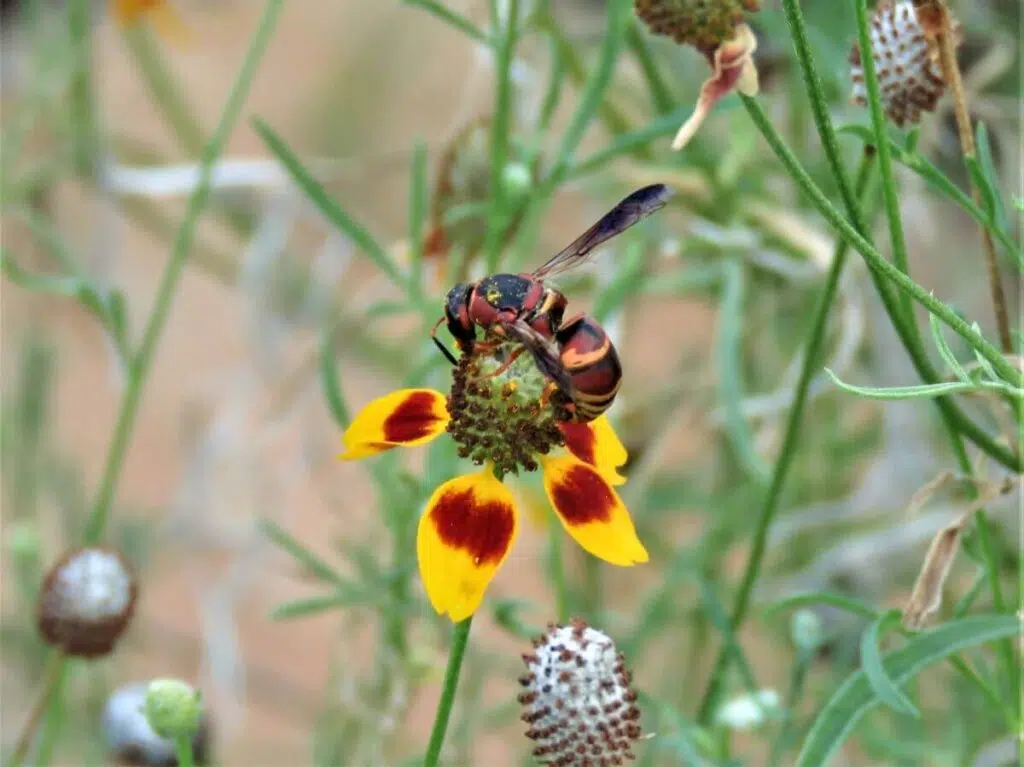
Hidalgo Mason wasp (Euodynerus hidalgo) has red, black, and yellow coloring.
Red is the dominant color and it can sometimes have a brown nuance.
Wide black bands and narrow yellow bands are also specific to this species.
Adult Hidalgo Mason wasps feed on pollen.
These wasps live solitary lives and they seek out caterpillars to feed to their larvae.
Female Hidalgo Mason wasps live solitary lives and find holes and cracks in wood to turn into nests.
5. Red-marked Pachodynerus Wasp

This species of wasps (Pachodynerus erynnis) have dark red and black coloring. It’s’ found in the US in states such as Florida.
Male wasps are also known to have a yellow band.
It’s believed this yellow coloration seen on males helps with communication.
The Red-marked Pachodynerus wasps live a solitary lifestyle.
Clearly stating this species has economic importance is difficult since these wasps live on their own.
They do not build communal nests but prefer to find holes and cracks in wood which they use as provisional nests.
Red-marked Pachodynerus wasps are also known for capturing live caterpillars. These living caterpillars are then fed to their larvae and sealed in their nests.
6. Rusty Spider Wasp
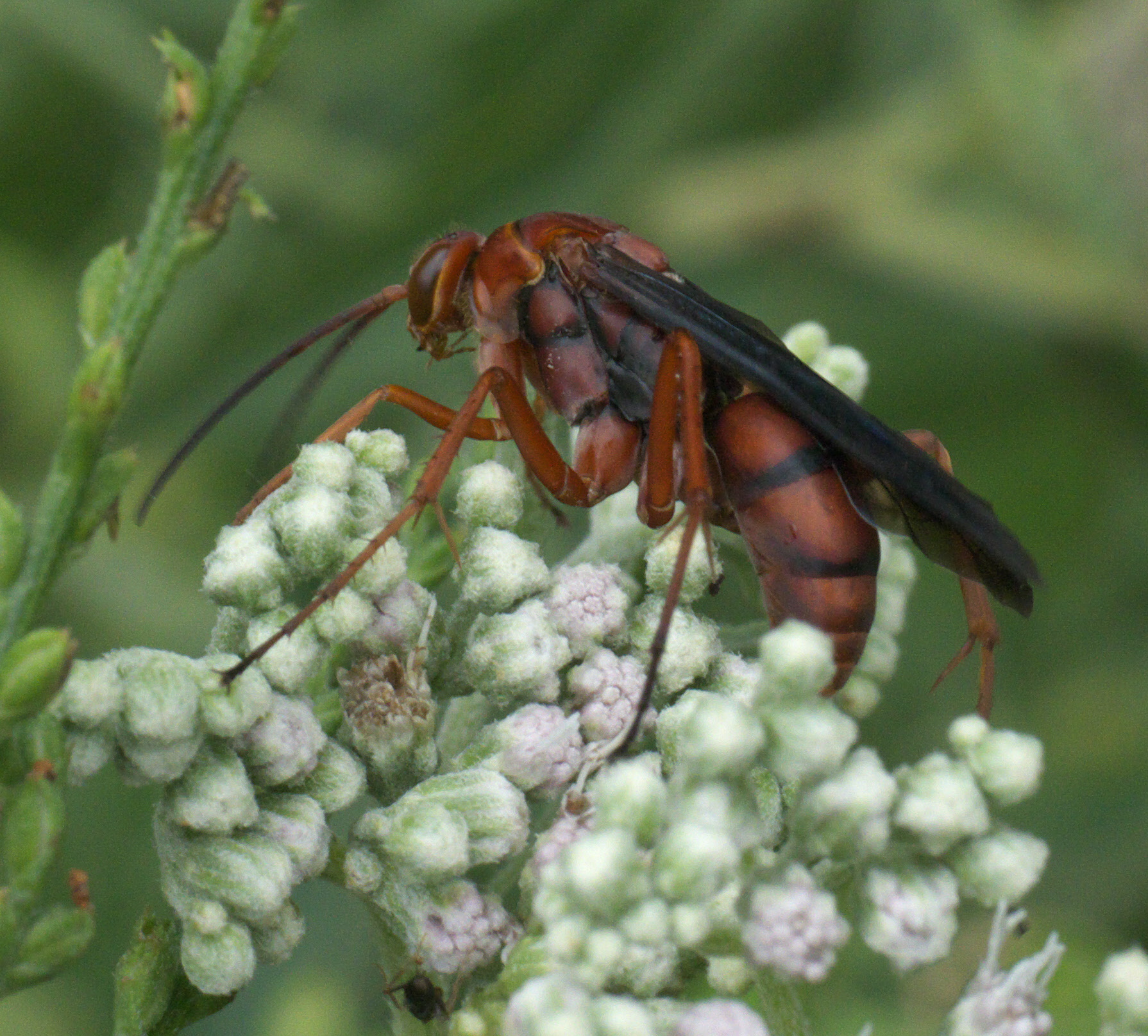
This wasp (Tachypompilus ferrugineus) grows to a maximum size of 25mm. It has a red-brown color backed by black bands across the abdomen.
Wasps of this genus can be distinguished from other red and black species by their colored wings.
Rusty Spider wasps have either blue or violet wings.
These wasps also stand out for eating spiders.
The female can sting spiders and drag them back to the nest to feed its larvae.
One of the distinct traits of the female wasp is the preference for very large spiders.
Some of the spiders the female has to kill are a few times larger than the wasp itself. Dragging a very large spider back to the nest can take hours for this species.
7. Limonethe maurator

This wasp has a mostly black body with red rear legs and a red abdomen.
The species is only present in Southeastern US territories with expanding range on the Eastern Coast.
Most common in Florida, this dark wasp is a known pollinator of Bidens Alba flowers.
Apart from its almost uniform black appearance, the wasp also has long black antennae with white bands.
The wasps show a parasitic behavior characteristic of ichneumon wasps.
8. Elegant Grass-carrying Wasp
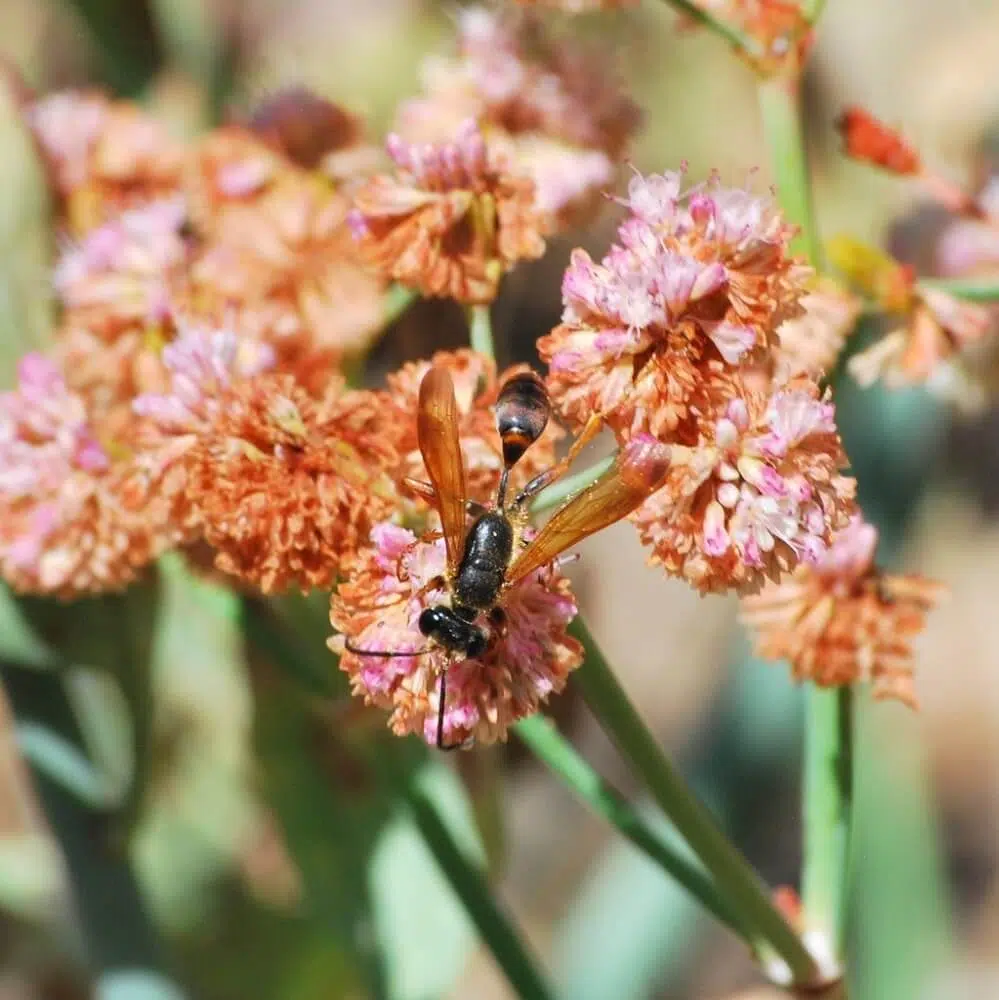
Elegant Grass-carrying wasps (Isodontia elegans) have a red abdomen with black bands. The rest of the body including the head is black.
The range of the wasp has been known to be in the South. However, it has now expanded its territory across Northern states as well.
The name of the species is inspired by the capacity of the wasps to carry grass.
Females of the species carry grass to enclose their nests and to add dividing walls for their eggs.
9. Euodynerus crypticus

This wasp species has a red-brown almost ferruginous color with black and yellow stripes and black marks on its head.
The species is common in the Northeast.
It lives solitary lives and females build nests in the ground, mainly within short distances from other individual nests as burrows.
The female digs a vertical burrow where eggs are laid and enclosed with mud until they hatch.
All females need a water source to mix dirt and to have it as mud to use in the ground.
Caterpillars are fed to the emerging larvae.
10. Slosson’s Mason Wasp

Slosson’s Mason wasp (Zethus slossonae) is one of the enigmatic red and black wasps of Florida.
This species has been described by older scientific literature and remains largely unknown today.
Some say this species only nests in old burrows already used by other insects. Others say it builds its nests in the ground.
You can identify the species by the very narrow petiole, its red abdomen, and its red and black body.
The economic significance of the species is reduced to non-existent due to its solitary nature.
Wasps of the genus lay eggs in the ground either in clusters or in separated mud chambers.
Many of these nests are found on trees, shrubs, or the ground.
Lepidopterous larvae or caterpillars are fed to the emerging young wasps.
11. Parker’s Thread-waisted Wasp

Wasps of this family (Prionyx parkeri) have an almost entirely black body and legs. Only the abdomen is red.
Mostly resembling flies, this species is known for its predatory behavior.
It feeds on spiders and larvae of other insects and pollen as adults.
Parker’s Thread-waisted wasps have a very basic social life living in a small nest of just a few individuals.
These are parasitic wasps that can easily eliminate existing specie of an underground nest to lay their eggs and establish their own nest.
Wasps of this genus are all parasitic. Many thread-waisted wasps show parasitic behaviors and an almost all-black body.
12. Eastern Tawny-horned Spider Wasp

Eastern Tawny-horned Spider Wasps (Entypus unifasciatus) are present all across North America, especially in the East, Central, and Southern parts.
This species of wasp is highly venomous. Its pompilodotoxin is known to be very painful to the extent a stung person can faint.
The sharp pain associated with its sting is caused by its venom which is used against spiders.
Wasps of this genus are known for stinging and paralyzing whole spiders which they feed to their young.
You can identify the Eastern Tawny-horned Spider wasp by its almost completely black body and red or orange wings. Its antennae are also red.
The species has a reduced to low impact pollination role.
13. Thisbe’s Tarantula-hawk Wasp

Thisbe’s Tarantula-hawk wasp (Pepsis thisbe) has a black body with orange-red wings.
This species grows to a size of up to 2 inches and it’s the most common tarantula wasp in the area of the Grand Canyon.
This insect is a nectavore. It means as an adult, it feeds on flower nectar.
However, these hawks also eat tarantulas as larvae. It’s the female Thisibe’s Tarantula-hawk wasp that brings tarantulas to its larvae.
The female has a potent stinger it uses to paralyze large tarantulas and then drag them to the larvae.
One of the most feared black and red wasps, Thisbe’s Tarantula-hawk wasp has a very painful sting.
It’s believed this sting is the second most painful sting in the entire world of insects so it’s best to stay clear of these wasps.
The female wasp might not sting directly without some type of provocation.
14. Toltec Potter Wasp
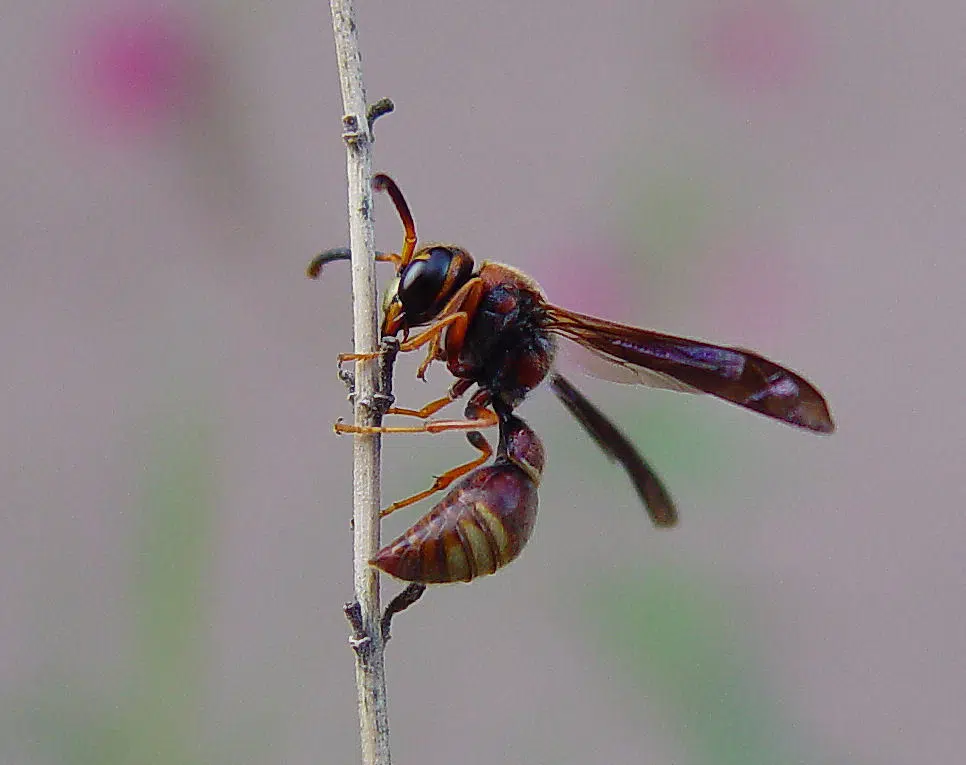
Toltec Potter wasps (Parazumia tolteca) are common in Southern states such as Texas.
These wasps are known for their thin petiole and they are among the species with black, red, and yellow colors.
Black and red colors are visible on its entire body while yellow coloring is present in the form of bands around the abdomen.
The legs of the species are yellow while its antennae are red, black, and yellow.
The male of the species has fewer yellow bands and yellow marks than the female.
These wasps are solely known for eating pollen as adults as they’re seen on various flowers during the day.
15. American Blue-black Spider Wasp
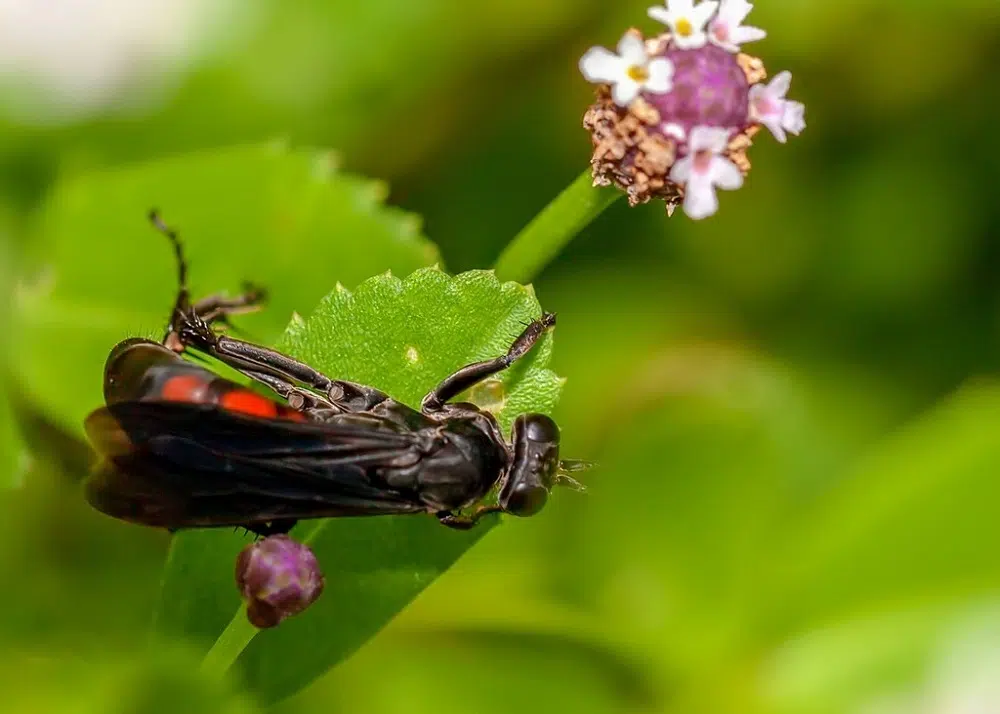
This species (Anoplius americanus) has a uniform black color and a red or orange lower abdomen.
Its wings, legs, and antennae are all black.
Wasps of this genus grow to a maximum size of 20mm but many are smaller measuring around 15mm.
They can be seen on an extensive range of wildflowers including asters and those of the buckwheat family.
The wasps help pollination of these species, but not to a considerable extent so that the flowers are dependent on them.
American Blue-black Spider wasp catch and feed spiders to their larvae.
Spiders such as Wolf spiders are caught by the female which then lays them in the nest for a single larva to feed on them for protein to grow.
Adults don’t eat Wolf spiders.
16. Caribbean Scoliid Wasp

Caribbean Scoliid wasps (Dielis dorsata) have a black body and 2 orange-red segments on the body.
These wasps are common in Florida and neighboring states.
They have known parasites and possess a painful sting.
Caribbean Scoliid wasps are parasites of scarab beetle larvae.
The female Caribbean Scoliid wasps burrow into the ground looking for beetle larvae it paralyzes with its potent sting and lays an egg upon.
The role of the Caribbean Scoliid wasps in pollination is minimal.
They are mainly seen on wildflowers rather than on flowers found in parks and gardens.
17. Fine-backed Red Paper Wasp

This species (Polistes carolina) is known for its rust-red color with or without black marks.
Male Fine-backed Red paper wasps have larger black marks compared to females.
These wasps are known as social insects that live together in nests they make. These nests are made with a combination of wood and saliva into a paper-like texture.
The queen is the main wasp dominating the nest. Female workers also help maintain the nest.
Queen Fine-backed Red Paper wasps are responsible for mating and establishing a colony. They only mate once.
Once the queen dies, one of the foundress female wasps takes on the role of the leader.
It can take up to a month for Fine-backed Red Paper wasps to re-establish the role of the queen and to make the nest and colony functional once again.